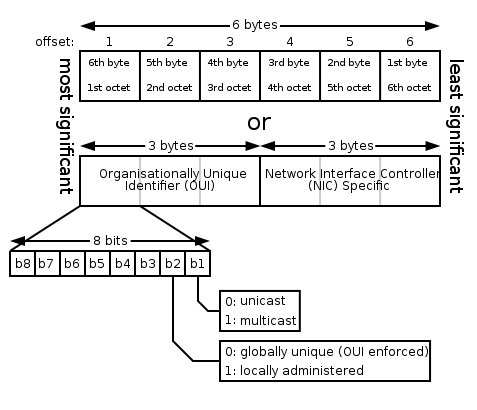

In this example, the receiver is not on the same subnet. This is accomplished by checking the destination IP address against the local subnet. The sender performs a simple check to verify if the receiving device is on the same subnet. Before the sender has the ability to encapsulate any data, it must first understand where the destination is located. Figure 2-2 illustrates the first step in this process. To better explain what happens to a packet traversing the network, we will walk you through the Layer 2 and Layer 3 transmission process.

From a Layer 2 perspective, this is only part of the story. In that chapter, you learned the uniqueness of IP multicast packets compared to unicast and broadcast packets. The diagrams in Chapter 1 show much of this processing in action.
#Multicast to mac address converter how to
A data transmission at Layer 4 is called a segment, a packet at Layer 3, and a frame at Layer 2.Īt each step through a network, routers and switches use these encapsulation headers and footers to make decisions about how to treat data transmissions. This allows data to be passed physically to the appropriate machine or the next hop in a network. Finally, Layer 2 adds hardware forwarding information (source and destination MAC addresses). Layer 3 adds logical forwarding details (source and destination IP addresses) so that networking devices can determine the best path toward a destination. This allows an operating system to forward data to an appropriate application or subroutine. For example, TCP port 80 is typically web traffic. This information is encapsulated in TCP and/or UDP with specific port numbers. Take a look at Figure 2-1 to understand how this works.įigure 2-1 OSI Model and Data Encapsulationĭata from the application, presentation, and session layers (Layers 1, 2, and 3) is encapsulated at Layer 4 with transport protocol information. At each layer of the OSI reference model, the data is processed, encapsulated, and sent to the next layer. This information is added in the form of headers and footers. Think of it like an onion, with many layers. Encapsulation is the method by which information is added at each layer of the OSI reference model, used for processing and forwarding purposes. Encapsulation is an important component of the OSI model for data communication and is absolutely essential in IP networks. Layered Encapsulationīefore reviewing multicast in Layer 2, we must discuss fundamental packet-forwarding concepts to establish a baseline of the process. This chapter covers the basic elements of multicast functionality in Layer 2 domains as well as design considerations for multicast deployments. This chapter takes an in-depth look at IP multicast messages at Layer 2 and how they are transported in a Layer 2 domain. We have talked about mac addresses used in multicast world and the 32 same ip addresses that is used with the same mac addresses.Chapter 1, “Introduction to IP Multicast,” examined the differences between unicast, broadcast, and multicast messages. In this lesson, we have learned an important lesson of multicast technology. For another Multicast MAC, there are another 32 ip addresses certainly. This is tru for all these 32 ip addresses.

These Multicast IP Addresses that can be used with this created MAC Address are given below:įor example like 224.255.0.1 multicast ip address, 230.127.0.1, 232.255.0.1, 238.255.0.1 ip addresses will also use the same MAC that we have produced. Here, with the 5th, 6th, 7th, 8th and 9th bits, 32 different Multicast IP Addresses can be written. So, 2^5, you can create 32 different IP address with this changable area.įor our example, the Multicast IP addresses that share the same Multicast MAC Address are showed below. And the remainning 5 bits in the middle can be any value. The last 23 bits are used for Multicast MAC Address. It is 25 bits.Ĥ) Lastly, we will combine the fixed 25 bits with the last 23 bits of the multicast ip to create our Multicat MAC Address :Ġ0000001:00000000:01011110:0 1111111.00000000.00000001 = 01:00:5e:7F:00:01įor Multicast IP Address, the first 4 bits are fixed, these first four bits are 1110. 3) We will take the fixed part of the Multicast MACs like below and we will write it in binary format.


 0 kommentar(er)
0 kommentar(er)
